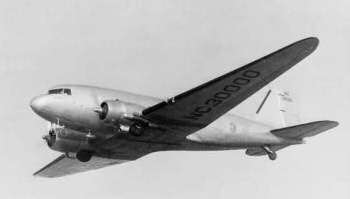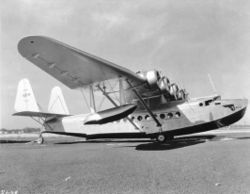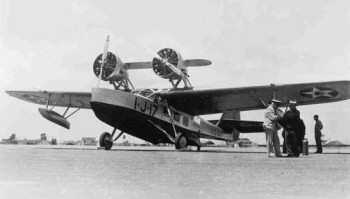
Air Transport in the 1930s
An article for Trail of Cthulhu players by Simon Carryer
The 1930s were known, for good reason, as the "Golden Age of Flight". Technical advances in aviation technology fuelled by the Great War, combined with swiftly developing mass-production, and an increasingly global network of industry and trade, would take commercial air travel from a novelty and a luxury at the start of the decade, to a necessity by its conclusion. Throughout the world, air lanes were opening, and the most remote regions were gradually being connected to the rest of the world by air.

It was a different time, and air travel was still a very new technology. While today travelling by air is ubiquitous, in the 1930s, travel by rail or by sea was the norm. Railways and shipping had developed a standard of luxury and economy that was impossible for air travel to beat. Aircraft of the decade were not capable of the altitudes of modern craft. This exposed them to turbulence that the smaller, lighter craft were poorly suited to weather. Travel by air was often a bumpy ride. Importantly, these low altitude flights were also susceptible to variations in weather, while navigation was imprecise, particularly over uncharted or isolated areas. All this made flight times much less reliable than they are today. Some of this variation from course was deliberate. Reportedly, some pilots liked to make detours to spot wild animals or famous landmarks. Unscheduled stops for fuel or to service unreliable aircraft were also common. In tropical areas, flight paths varied seasonally as rains rendered some airfields unusable.
While flying was more expensive, less comfortable, and potentially more dangerous than travel by train or boat, there was one area in which air travel could compete with more conventional means of transport, and compete strongly: Speed. Air travel, especially in inhospitable or remote locations, was a great deal faster than any other means. Surveys from the time reveal that speed was the number one factor people considered when choosing to fly. The high cost, however, meant that for most of the decade, air travel was the preserve of the upper classes, those who had the money to travel by air as a novelty, or businessmen who operated national or international concerns. Passenger aircraft were fitted to suit this high-class clientele. Plush, upholstered seats, wet bars, smoking lounges and wooden panelling all gave the impression of luxury, despite engine noise and turbulence. Other innovations served to make air travel stand out from its competitors. Passengers could reserve seats by telephone with many airlines, and regular customers could purchase pre paid "scrip" - paper coupons which often allowed for discount rates. Stewards, who for most of the decade were required to be male, would help passengers with luggage, offer a sandwich mid-flight, and tend to the airsick.

Changes in the way we travel make it difficult to assess the relative danger of air travel in the 1930s, compared to other forms of transport. Twenty-five people, worldwide died in air crashes in the year 1932, yet it's difficult to compare this figure to any comparative statistic from land or sea. Certainly air travel was perceived as dangerous, and insurance rates for air trips were four times the price of the same insurance travelling by rail.
Air Travel By Region
The degree to which air travel was available, and the regions which could be reached by air, varied enormously by year and by continent. What follows is a breakdown of some major areas and their history of aviation, with a focus on what kinds of flights would be available, and where.
North America
Flights across the North American continent became increasingly common and popular throughout the 30's, thanks in no small part to the introduction of the Douglas DC-2, and from 1935, the ubiquitous DC-3. DC-3s enabled flights across America with comfort and speed heretofore unheard of. In 1934, an air trip between New York and Los Angeles would take almost 26 hours of flight, and require numerous stops and aircraft changes. By 1937, the introduction of the DC-3 had cut that time to just over 17 hours. With daytime and sleeper flights, upholstered seats, and the revolutionary introduction of female flight attendants (who were required to be registered nurses), air travel within the United States was, if not luxurious, at least comfortable.
China
As with previous decades, in the 1930s, Hong Kong was the gateway to China, and all international flights terminated at this British outpost. By 1937, trans-pacific flights from North America to China were becoming more regular, with a commercial run from San Francisco, through Honolulu, Midway, Wake Island and Guam, to Hong Kong. Imperial Airways also carried passengers and mail into Hong Kong as part of its mail route to Australia. Passengers on this line would stop in Penang before disembarking in Hong Kong.
The China National Aviation Corporation developed civil aviation in China throughout the decade, turning isolated cities serviced by antiquated, small aircraft, into a thoroughly modern air network by 1937. As with other countries, the flying boat was an invaluable part of air travel in China. Douglas "Dolphin" amphibious aircraft serviced the coast of China, while three Douglas DC 2 aircraft, capable of carrying 14 passengers each, ran regular routs to main centres in the interior. Older aircraft remained in operation throughout China for the duration of the decade.
Crossing the Atlantic
Passenger service between North America and Europe by air was not commercially developed until the very end of the 1930s. Long distances, changeable weather, and competition from reliable and popular crossings by ship made trans-Atlantic flights a difficult proposition for airline companies. Britain did not grant landing rights to American air carriers until 1936. A number of European companies made experimental flights across the Atlantic, carrying exclusively mail, using both dirigibles and seaplanes, but these flights were never commonplace. Prior to 1939, the most common way to cross the Atlantic by air was by zeppelin, and there were hundreds of such crossings between 1930 and 1937. 1939 saw the beginnings of the first commercial trans-Atlantic passenger flights, with the Pan American "Yankee Clipper" flying passengers between New York and Marseilles, France, or Southampton, England. The journey took about 29 hours, and cost $375 ($5,188 in today's terms) one way.
Africa and the Middle East
Imperial Airways' routes to Africa were the backbone of the Great Empire Air Route. As with other continents, the flying boat was a mainstay of air travel, and the Mediterranean was the hub of flying boat activity for the region. Flights to both the Middle East and Africa, as well as to India, would all pass through the Mediterranean, where the majority of passengers would transfer to flying boats. Egypt and the Sudan were linked by air with Central Africa from 1931. The Nile was another major centre for flying boats. By 1932, Imperial Airways flew as far south as Cape Town, and it was possible for passengers to travel from London to South Africa exclusively by air. There was little time saved by flying, rather than sailing, from London to South Africa, and the flight was likely to be more expensive, more dangerous, and less comfortable than sailing. However, within Africa, land transport was often slow and unreliable, and air travel was a popular alternative. A trip that might take three months by automobile, struggling through untracked desert or thick jungle, could take as little as three days by air, given suitable weather.
In addition to the main Empire routes, several smaller airlines offered limited services within Africa and the Middle East. Private operators, often with small two or four-seater planes, serviced the most remote regions. Two-seater flying boats were flying passengers and mail into the interior of the Congo as early as 1919. These antiquated aircraft remained in operation throughout the 1930s. Several European airlines offered seaplane service for mail between South America and West Africa, though these contracts never extended to regular passenger service.
The Pacific
Commercial air travel to Hawaii began in 1935 with a flying boat run between California and Honolulu (the flight took about 19 hours, and cost $278 ($4,046 today) one-way). This was part of a larger Pan Am flying boat route to China, travelling from San Francisco, through Honolulu, Midway, Wake Island, Guam, and finally terminating in Hong Kong. In 1936 these passenger flights were extended all the way across the Pacific, a round trip from San Francisco to Manila. The nine passengers on each of these flights paid an astronomical $1,400 (nearly twenty thousand dollars in modern day terms) for the privilege.
For these Pacific commercial fights the Sikorski S-40 and S-42 "Clippers" were the most popular planes throughout the thirties, capable of carrying over thirty passengers in relative comfort. The "China Clipper" which flew the San Francisco to Hong Kong route, was a stylish symbol of America's growing dominance of the air. The clippers could seat 32 passengers in four well-appointed cabins, and usually had a steward to attend to the passengers.
Imperial Airways flew passengers to Australia and New Zealand from 1934, crossing the Pacific in days, when the trip by sea could take weeks or even months. From Australia, Qantas Empire Airways flew mail routes into remote stations, and across the Tasman Sea to New Zealand. Britain refused to grant landing rights to American carriers into Australia, but the New Zealand government was more cooperative. In 1937 Pan Am flew their first passenger flights from San Francisco to New Zealand, via Honolulu and American Samoa.
South America
Pan American - Pan Am - Airways were synonymous with South American air travel, and to a lesser extent all international American commercial air travel, for the duration of the 1930s and beyond. Pan Am's first international flight was a mail run from Florida to Havana, and the 1930s saw the company develop their South American passenger and mail services extensively. Miami was the North American base for these flights, which connected with many points around the Gulf of Mexico and further South. There was a regular flying boat service from Florida throughout South America, with regular stops in Panama and Buenos Aires. These flights were the first of Pan Am's famous "Clipper" services, and popularised the flying boat as a passenger aircraft.
South America, with its mountainous landscape and many large rivers, was a perfect venue for flying boats and seaplanes. For most of the Thirties, much of South America was virtually inaccessible by land. The advent of cheaper, more reliable aircraft with the ability to land on water led to a boom of exploration in South America, with missionaries, archaeologists, and gold prospectors flocking to the region. Local airlines, often flying outdated aircraft, exploited this sudden rush of people and money to the region.
India
India was an important leg of the Empire Air Route, which passed through the Mediterranean, North Africa, Egypt, and the Middle East, before reaching India, then continuing on to Hong Kong and Australia. For much of the decade, large portions of the route had to be completed by rail or ship, due to the complicated politics of European airspace. Italy in particular was notoriously intransigent in granting rights for commercial flights to pass through her airspace. It was not until 1936 that the trip to India could be completed entirely by air. The major airport in India during the thirties was Calcutta, but Karachi and Durban were also serviced by air.
Within India, the extensive train network created by the British made air travel largely unnecessary for the majority of travellers. Private operators of course, were active in all parts of the globe, and India was no exception.
Zeppelins

The 1930s saw the rise and fall of zeppelins as a popular form of public transport. Even at the height of their popularity, however, zeppelins were never a common sight, and travel by zeppelin was always seen as a luxury, rather than necessity. Zeppelins were appointed far more like a seagoing vessel than an aircraft. This extended even to the flight controls, which were handled just as onboard a ship, with a captain relaying orders to engine crew, while relying on several pilots and a navigator for steering and information. The Graf Zeppelin was by far the most commercially successful airship of its time, flying regular trans-Atlantic flights between Europe and America until 1936, as well as making visits to the Middle East, South America, and even the Arctic. Famously, zeppelins fell from popularity sharply with the Hindenburg crash of 1937. Deteriorating relationships between Nazi Germany and the United States of America ensured that zeppelins' fortunes would not be revived.
Adventure Seeds
What follows are a few ideas for ways that one could incorporate the unique aspects of 1930s air travel into your game.
Lost
For long-distance flights across the Pacific and Atlantic, flying boats were used for their ability to land at several points along the way to refuel. To achieve this, the aircraft would rendezvous with a supply ship at an agreed location. These locations were often tiny, never-before-visited atolls and islands. Kingman Reef, a sandbar that barely rose more than a meter above sea level, in almost the exact centre of the Pacific, was one such rendezvous point, used in the inaugural passenger flight from North America to New Zealand. The reef was absent from even the most meticulous sea charts until the late 1920s. A flight crew, or the passengers of such a flight, would be alarmed to discover their supply ship abandoned, Signs that the crew of the ship had departed for the interior of the island would only deepen the mystery.
To the Antarctic by Zeppelin
Zeppelins, with their ability to remain afloat without power, were an ideal aircraft for crossing inhospitable and unexplored terrain. The Graf Zeppelin's trip to the Arctic inspired many explorers and inventors to try similar feats. While no other successful trips to the Arctic or Antarctic by Zeppelin have been recorded, such a venture is by no means impossible. What antediluvian horrors lie undiscovered beneath the ice is best left to the imagination. The frequent mechanical troubles that plagued lighter-than-air flight would certainly complicate any attempt to scientifically study such cyclopean ruins as were found.
Flying to Inland Waters
The flying boat opened up to the foreign explorer the
interiors of lands previously un-trod by all but native feet. From the late
1920s, the perfect mixture of improving technology giving rise to a plethora of
flying boats and seaplanes, with an excess of trained pilots from the Great War,
made such unexplored regions only a few hours' flight away. South America, the
Congo, the remotest regions of India, all became suddenly accessible. Any lake
or large enough river was a sufficient landing point for the tiny two and
four-seater craft. The remains of decaying civilisations, bastions of dark
cults, the ruins of temples to forgotten gods, the last survivors of lost
expeditions, turned barbarous and strange by their long absence from
civilisation, all wait, hidden, beneath the jungle canopy and choking vines of
such regions.

You Take the High Road...
Along many air routes, carriers gave preference to mail over passengers. Reliable and lucrative, mail required none of the comfort or attention of passengers, and could be counted on to provide a healthy return. This situation meant that often space could be found for mail where none could be found for passage. Booking clerks were instructed to avoid, if possible, selling space to passengers. For example, on the Imperial route from India, only five passengers were accepted each week. In 1937, only seven passengers a week were permitted to board the two weekly flights to and from Durban. For an archaeologist or anthropologist eager to gain credit for an extraordinary find, the temptation to send such an artefact home by air, while returning by sea or rail themselves, must have been enormous. What havoc such an item might have caused in the hands of unsuspecting baggage handlers, junior members of faculty, or some unsuspecting member of the public delivered the package in error does not bear speculation.
References
- US Centennial of Flight Historical Essays
- Tales of Old Shanghai
- Imperial Airways History
- Passenger traffic in the 1930s on British imperial air routes
- The Aviation Industry by Myron W. Watkins
Related Links
- Discuss this article.
- Trail of Cthulhu webpage
- Trail of Cthulhu Pelgrane blog entries
- Writer Simon Calyer's PBP forum
